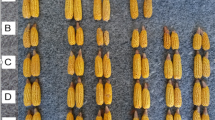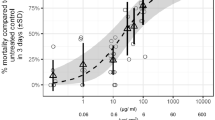Abstract
Use of seed treatments in Integrated Pest Management of major field crops has increased considerably over the past few years. However, field recommendations are seldom supported by in vitro assays screening the suitability of the pesticides for seed treatment. Hence, the present investigation was undertaken to assess the suitability of three insecticides as imidacloprid (600 FS), fipronil (5 FS) and chlorpyriphos (20 EC) for seed treatment in chick pea as well as to verify the compatibility of identified doses of test-insecticides, along with biofertilizer (Mesorhizobium ciceri @ 25 g/kg seed) and in combination with biofungicide (Trichoderma harzianum @ 4 g/kg seed). Ten treatments were evaluated in insecticidal studies viz. control and three treatments of each insecticides i.e. nine treatments) and eight treatments were evaluated in compatibility study. Based on the results obtained, the authors advocate appropriate IPM-compatible and eco-friendly seed treatment tactics, viz., (1) imidacloprid @ 5 ml/kg + Mesorhizobium, (2) imidacloprid @ 5 ml/kg + Mesorhizobium @ 25 g/kg seed + Trichoderma @ 4 g/kg seed, (3) fipronil @ 5 ml/kg + Mesorhizobium @ 25 g/kg seed, and (4) fipronil @ 5 ml/kg + Mesorhizobium @ 25 g/kg seed + Trichoderma @ 4 g/kg seed. These recommendations may be tested for the field level efficacy and the insecticides tested hereby are essentially termiticides, but recommendations can well be adopted for sucking insect pests for good agricultural practices in chickpea.






Similar content being viewed by others
References
AICRP on Chickpea (2016) All India Coordinated Research Project on Chickpea website homepage. http://www.aicrpchickpea.res.in. Accessed 29 July 2016
Brown SC, Gregory PJ, Cooper PJM, Keatinge JD (1989) Root and shoot growth and water use of chickpea (Cicer arietinum) grown in dryland conditions effects of sowing date and genotype. J Agric Sci 113:41–50
Krouma A (2010) Plant water relations and photosynthetic activity in three Tunisian chickpea (Cicer arietinum L.) genotypes subjected to drought. Turk J Agric For 34:257–264
DPPQR&S (2001) Directorate of Plant Protection, Quarantine & Storage, IPM program for groundnut. http://www.ppqs.gov.in. Accessed 22 June 2013
Atwal AS (1976) Agricultural pests of India and South East Asia. Kalyani Publishers, New Delhi
Campaign for Seed treatment (2007) Directorate of Plant Protection, Quarantine & Storage. http://www.ppqs.gov.in. Accessed 2 June 2012
ISTA (2008) International Seed Testing Rule, 2007. Published by International Seed Testing Association, Zurich
Abdul-Baki AA, Anderson JD (1973) Vigor determination in soybean seed by multiple criteria. Crop Sci 13(6):630–633. doi:10.2135/cropsci1973.0011183X001300060013x
Mesta RK, Benagi VI, Kulkarni S, Shankergoud I (2009) In vitro evaluation of fungicides and plant extracts against Alternaria helianthi causing blight of sunflower. Karnataka J Agric Sci 22:111–114
Jarande NT, Dethe MD (1994) Effective control of brinjal sucking pests by imidacloprid. Plant Prot Bull 46:43–44
Ghosh TK, Tyagi MK, Duhan JS (2003) Rhizobial compatibility against lethal doses of pesticides in greengram with different methods of inoculation. Indian J Agr Res 37:120–123
Guene NFD, Diuof A, Gueye M (2003) Nodulation and nitrogen fixation of field grown common bean (Phaseolus vulgaris) as influenced by fungicide seed treatment. Afr J Biotechnol 2:198–201
Fox JE, Gulledge J, Engelhaupt E, Burow ME, McLachlan JA (2007) Pesticides reduce symbiotic efficiency of nitrogen fixing rhizobia and host plants. Proc Natl Acad Sci USA 104:10282–10289
Narasimhulu T, Kameshwara RP (1989) Effect of seed treatment with insecticides and fungicides on the germination of peanut seed. Seed Res 17:159–163
Chaudhary OP, Dashad SS (2002) Cultivar sensitivity to insecticides used as seed treatment to control termites in chickpea. Ann Agr Res 23:259–262
Dhillon RS, Singal SK, Bhanot JP (2001) Effect of insecticides and other products on germination of green gram seeds. J Insect Sci 14:91–92
Charjan SKU, Tarar JL (1993) Efficacy of systemic insecticides and fungicides on seed germination and seedling growth of sesame. Ann Plant Physiol 7:126–130
Gaikwad SK, Pawar VM (1979) Effect of systemic insecticides on the germination and seedling development of okra. Seed Res 7:28–33
Chaudhary OP, Kashyap RK, Dahiya BS, Arya B (2001) Varietal sensitivity to insecticidal seed treatment and germination inhibition in wheat. Seed Res 29:189–196
Chopra SL, Chandra KS (1969) Effect of thiometon on the germination of sarson (Brassica campestris var Brown sarson). J Agr Food Chem 17:805–809
Scopes NEA (1969) Some quantitative effects of soil-applied organophosphorus insecticides on crop growth. Plant Pathol 18:10–15
Gifford JR, Burkhardt CC, Somsen HW (1959) Effects of thimet and various stickers on germination and seedling growth of wheat. J Econ Entomol 52:650–654
Thube SH, Mahapatro GK, Arun Kumar MB (2014) In vitro evaluation of insecticidal seed treatments in wheat. Indian J Ent 7(3):215–218
Chandrashekar K, Gupta O, Yelshetty S, Sharma OP, Bhagat S et al (2014) Integrated Pest Management for chickpea. ICAR - NCIPM, Pusa, p 43
Jayaraj J, Ramabadran R (1999) Rhizobium - Trichoderma interaction in vitro and in vivo. Indian Phytopath 52(2):190–192
Cheema HK, Sharma P, Singh R, Taggar GK, Khanna V, Kooner BS (2009) Efficacy and compatibility of insecticides, fungicide and rhizobium inoculant in combination for seed treatment in chickpea. Indian J Agr Sci 79:190–194
Acknowledgments
The senior author is grateful to Indian Council of Agricultural Research (ICAR) for providing Junior Research Fellowship. Due acknowledgement is expressed to the authorities of Divisions of Entomology, Seed Science and Technology, Microbiology, Plant Pathology and Genetics, and Central Library of IARI for requisite infrastructure and facilities for undertaking this study. This work was also supported by the National Fellow ICAR project.
Author information
Authors and Affiliations
Corresponding author
Ethics declarations
Conflict of interest
The authors declare that they have no conflict of interest.
Rights and permissions
About this article
Cite this article
Thube, S.H., Mahapatro, G.K. & Arun Kumar, M.B. In vitro Evaluation of Insecticides, Bio-Fungicide and Bio-Fertilizer for Strategic and Eco-Friendly Combinatorial Seed Treatments in Chickpea. Proc. Natl. Acad. Sci., India, Sect. B Biol. Sci. 88, 645–654 (2018). https://doi.org/10.1007/s40011-016-0794-z
Received:
Revised:
Accepted:
Published:
Issue Date:
DOI: https://doi.org/10.1007/s40011-016-0794-z




